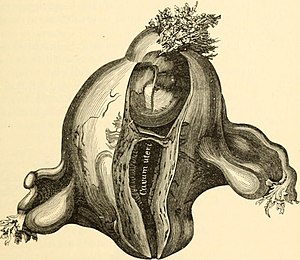Cornual pregnancy
| Interstitial Pregnancy | |
|---|---|
 |
|
| Classification and external resources | |
| ICD-10 | O00.8 |
| ICD-9-CM | 633.1 |
An interstitial pregnancy is a uterine but ectopic pregnancy; the pregnancy is located outside of the uterine cavity in that part of the fallopian tube that penetrates the muscular layer of the uterus. The term cornual pregnancy is sometimes used as a synonym, but remains ambiguous as it is also applied to indicate the presence of a pregnancy located within the cavity in one of the two upper "horns" of a bicornuate uterus. Interstitial pregnancies have a higher mortality than ectopics in general.
The part of the Fallopian tube that is located in the uterine wall and connects the remainder of the tube to the endometrial cavity is called its "interstitial" part, hence the term "interstitial pregnancy"; it has a length of 1–2 cm and a width of 0.7 cm. Its borders are the opening (ostium) of the tube to the endometrial cavity within the uterus and, laterally, the visible narrow segment of the tube. The area is well supplied by the Sampson artery which is connected to both the uterine and the ovarian arteries. Surrounded by uterine muscle (myometrium) it can expand significantly when it hosts a pregnancy.
Interstitial pregnancies can be confused with angular pregnancies; the latter, however, are located within the endometrial cavity in the corner where the tube connects; typically those pregnancies are viable although a high rate of miscarriage has been reported. A pregnancy located next to the interstitial section laterally is an isthmic tubal pregnancy.
The definition of an ectopic pregnancy is a pregnancy outside of the uterine cavity, not outside of the uterus, as the interstitial pregnancy is still a uterine pregnancy.
Interstitial pregnancies account for 2–4% of all tubal pregnancies, or for 1 in 2,500 to 5,000 live births. About one in fifty women with an interstitial pregnancy dies. Patients with an interstitial pregnancies have a 7-times higher mortality than those with ectopics in general. With the growing use of assisted reproductive technologies, the incidence of interstitial pregnancy is rising.
Early diagnosis is important and today facilitated by the use of sonography and the quantitative human chorionic gonadotropin (hCG) assay. As in other cases of ectopic pregnancy, risk factors are: previous tubal pregnancy, IVF therapy, tubal surgery, and a history of sexual infection. Typical symptoms of an interstitial pregnancy are the classic signs of ectopic pregnancy, namely abdominal pain and vaginal bleeding. Hemorrhagic shock is found in almost a quarter of patients.; this explains the relatively high mortality rate.
...
Wikipedia
